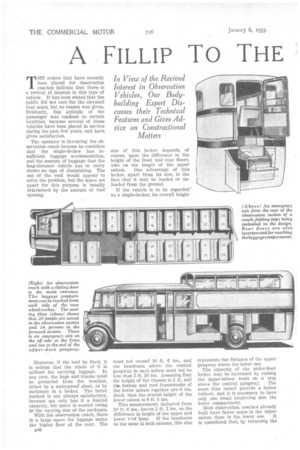A FILLIP To THE
Page 60

Page 61

If you've noticed an error in this article please click here to report it so we can fix it.
DBSERVATION COACH
THE orders that have recently been placed for observation coaches indicate that there is a revival of interest in this type of vehicle. It has been stated that the public did not care for the elevated rear seats, but no reason was given. Evidently, this attitude of the passenger was confined to certaia localities, because several of these vehicles have been placed in service during the past few years, and have given satisfaction.
The operator is favouring the observation coach because he considers that the single-decker has insufficient luggage accommodation, and the amount of baggage that the long-distance vehicle has to carry shows no sign of diminishing. The use of the roof would appear to solve the problem, hut the space set apart for this purpose is usually determined by the amount of roof opening.
Moreover, if the roof be fixed, it is seldom that the whole of it is utilized for carrying luggage. In any case, the bags and trunks must be protected from the weather, either by a waterproof sheet, or by enclosure in a locker. The latter method is not always satisfactory, because not only has it a limited capacity, but space is wasted owing to the varying size of the packages.
With the observation coach, there is a large space for luggage under the higher floor at the rear. The .1346 size of this locker depends, of course, upon the difference in the height of the front and rear floors, also on the length of the upper saloon. One advantage of this locker, apart from its size, is the fact that it may be loaded or unloaded from the ground.
If the vehicle is to be regarded' as a single-decker, its overall height must not exceed 10 ft. 6 ins., and the headroom ahove the central gangway in each saloon must no be less then 5 ft. 10 ins. Assuming that the height of the chassis is 2 ft. and the bottom and roof frameworks of the lower saloon together are 6 ins. thick, then the overall height of the lower saloon is 8 ft. 4 ins.
This measurement, deducted from 10 ft. 6 ins., leaves 2 ft. 2 ins, as the difference in height of the upper and lower rnof lines. If the headroom be the same in both saloons, this also represents the distance of the upper gangway above the lower one. The capacity of the under-floor locker may be "increased by raising the upper-saloon seats on a step above the central gangway. The seats thus raised provide a better outlook, and it is necessary to have only one tread projecting into the lower compartment.
Most observation coaches already built have fewer seats in the upper saloon than in the lower one. It is considered that, by reversing the proportion of seats, there is less likely to be any feeling of isolation amongst the upper-saloon passengers. This may have been a reason for disliking the upper saloon. Moreover, by increasing the length of this part of the coach, there is space for a locker and door on• each side of the wheel-arches.
The observation coach is an attractive proposition, because there is no wheel-arch problem, and it may have a maximum number of seats all facing forwards. With regard to the main entrance, this may be in any position on the near side of the lower saloon. Some builders favour a sliding door immediately in front of the middle bulkhead, so that all passengers are about the same distance from the door. Furthermore, the passenger gains access directly either to the upper or lower saloon. The only drawback to this position of doorway is that the step to the upper compartment tends to obstruct the main gangway.
As the coach is to be a singledecker, it should require only one emergency exit. This is arranged conveniently on the lower deck on the off side. If this exit be close to the front bulkhead, the upper-saloon passengers may seem to be a long way from it, but any illusion of this kind is probably owing to the fact that the lower saloon is partly concealed by the middle bulkhead and one or two steps have to be negotiated.
Should another exit be considered desirable, it is placed at the end of the upper-saloon gangway, and descent is facilitated by means of folding steps. If maximum seating capacity be not required, the second exit may take the form of back stairs leading to the normal floor level.
When designing this type of bodywork, every effort should be made to provide the greatest possible amount of natural lighting in the upper saloon. The top of the screen is arched upwards and is flush with the roof. At the bottom, more window area is available by adopting a serpentine or semi-clerestory .outline for the cross-sectional shape of the lowersaloon roof.
This variety of roof may preclude the mounting of a standard pattern of sliding panel, but there should be no difficulty in making one with specially shaped hoopsticks. The opening roof is sure to be as popular with this type of coach as with the normal pattern, and, no doubt, many of them will have sliding roofs in both the forward and the rearward saloons.
Perhaps the most interesting feature of the observation coach is the middle bulkhead. It has a central opening about 2 ft. wide, and there is a small deck above it which connects it to the base of the front windows. The partitions at each side may be panelled with mirrors of some attractive shape.
It may be considered advisable that the upper part of these partitions be glazed.




























































































